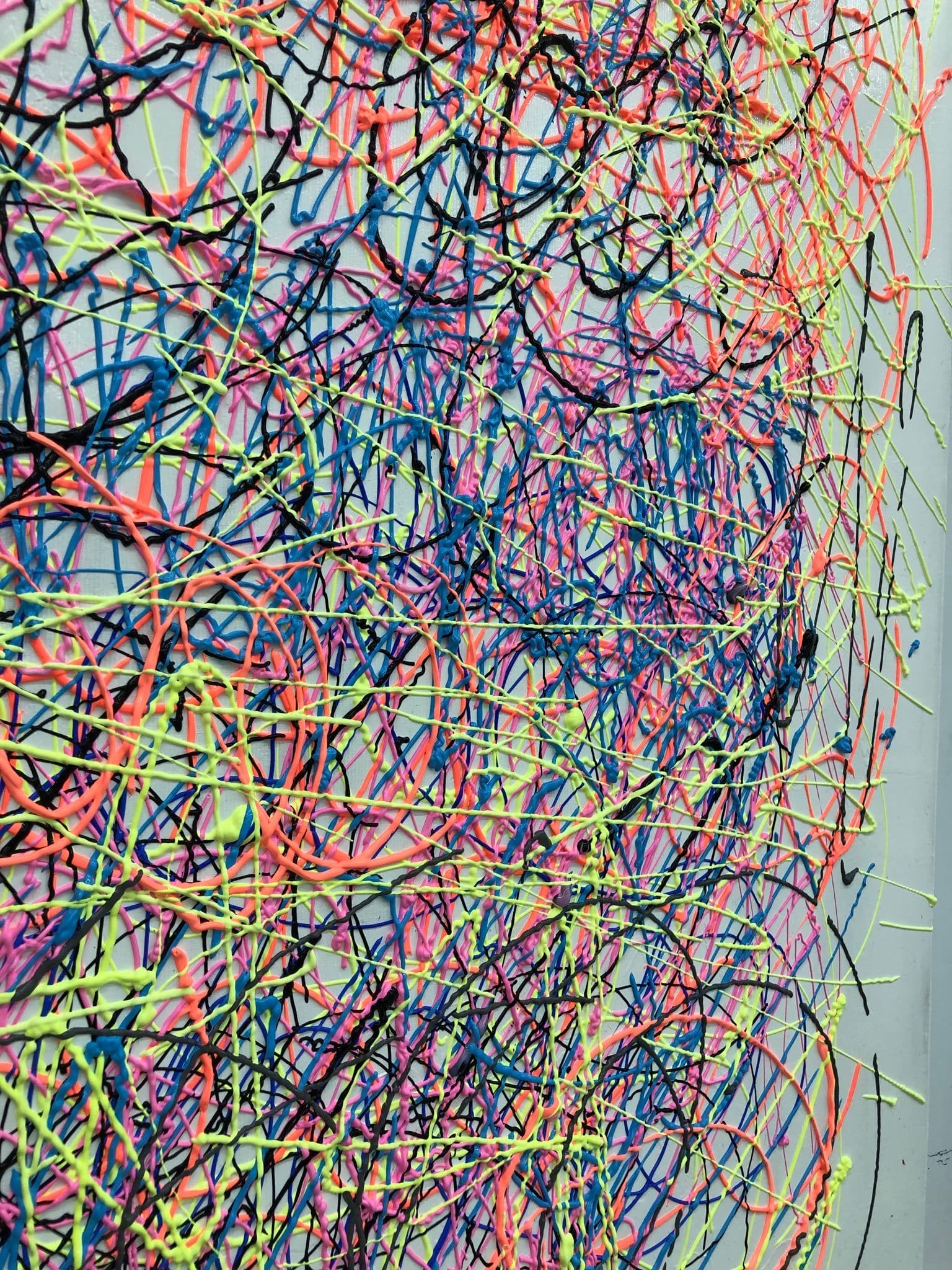Have you ever stood in front of a painting and felt as if you were witnessing a moment frozen in time, where every splatter and line holds an intense energy? If so, you might have experienced the revolutionary art of one of the most influential figures in the abstract expressionist movement. His innovative approach, characterized by his famous drip technique, catapulted him into the spotlight of the mid-20th century art scene. To see how this energy carries into contemporary decor, explore our Modern Abstract Paintings collection, where the spirit of Pollock lives on in texture, color, and motion. This method was not just a way of applying paint but an intense physical involvement, giving birth to what is now known as action painting.
Inspired by this powerful visual language, we've created a collection of original paintings in the style of Jackson Pollock – works that echo his raw energy, expressive motion, and emotional depth. Each piece is a tribute to the spontaneous spirit of action painting, turning chaos into harmony on canva
His canvases are battlegrounds of color and texture, where each drop and streak is a record of the artist's vigorous movements. His work also delves deep into the realm of Jungian symbolism, where each abstract form can be seen as an archetype from the collective unconscious.
He did more than merely paint with his innovative techniques and profound imagery: he invited people to watch his art in action, permanently changing the modern art world. In this article, we will look at 10 of his most fascinating paintings, each of which is an example of his ferocious inventiveness and depth on canvas.
1. Convergence (1952): A Masterpiece of Color and Chaos

Convergence, 1952 by Jackson Pollock
"Convergence" (1952) stands as a quintessential masterpiece within his legacy, encapsulating the chaotic vitality that defines his style. This work is characterized by explosive colors and intricate layers of drips, each contributing to an overall sense of dynamic energy and movement. As one of the early highlights of the abstract expressionist movement, "Convergence" is a testament to his innovative use of the canvas as an arena for action.
The painting is housed at the Albright-Knox Art Gallery in Buffalo, New York, where it continues to be a pivotal piece representing the early days of abstract expressionism. This artwork not only reflects Pollock’s deep engagement with color and form in motion but also illustrates his role in transforming the landscape of modern art with his unique approach to painting.
If you love that kind of vibrant chaos, our Colorful Abstract Paintings have many pieces that channel similar intensity and joy through colo
2. One: Number 31, 1950: Jackson Pollock’s Largest Painting

One: Number 31, 1950 by Jackson Pollock
"One: Number 31, 1950" is not just one of his largest paintings, but a monumental achievement in the realm of abstract expressionism, spanning an impressive 269.5 x 530.8 cm. Created during a prolific period in the summer-autumn of 1950, this work is one of three wall-sized paintings Pollock produced, and the zenith of his action painting technique. The sheer size of the canvas gave him an expansive arena to maneuver, facilitating a grand interplay of control and chaos.
3. Shimmering Substance (1945): The Transition to Non-Representational Art

Shimmering Substance, 1945 by Jackson Pollock
"Shimmering Substance" (1946) marks an important moment in his artistic career as it represents his first plunge into non-representational art. With dimensions of 76.3 x 61.6 cm, this relatively modest canvas is remarkable for its departure from representational forms, signaling his shift towards pure abstraction. The painting vibrates with a rhythmic energy that borders on the musical, reflecting a dense interplay of colors and textures that seem to dance across the canvas.
"Shimmering Substance" is a foundational work that hints at the dramatic innovations he would continue to develop in his later works, serving as a crucial link in understanding the evolution of his radical artistic expressions.
4. Mural on Indian Red Ground (1950): A Work of Immense Value

Mural on Indian Red Ground, 1950 by Jackson Pollock
"Mural on Indian Red Ground" (1950) is one of his most famous works sold for approximately $250 million. This painting, kept at the Tehran Museum of Contemporary Art, is a cornerstone in his collection, which represents his iconic style during a peak of his creative period. The artwork is distinguished by its vibrant use of an Indian red ground, which serves as a dramatic backdrop to energetic splatters and intricate drips.
5. The Deep Jackson Pollock (1953): Jungian Symbolism in Abstract Form

The Deep, 1953 by Jackson Pollock
"The Deep" (1953), a profound work, is housed at the Centre Georges Pompidou in Paris, France. The image of this painting is often interpreted as a deep hole or abyss, an image that powerfully reflects themes from Jungian psychology, particularly the exploration of the unconscious mind.
The stark use of black and white in this piece underscores the emotional depth and intensity of the abyss, as well as creates a striking visual contrast that accentuates the sense of an immeasurable depth. Pollock’s use of such dramatic images invites viewers to delve into their own subconscious, interpreting the abstract forms as a symbolic journey into the deeper recesses of the human psyche. "The Deep" stands out in his portfolio for its symbolic richness and the compelling way it captures the existential tensions of depth and surface.
If you’re drawn to such powerful contrast, you might also enjoy our Black & White Abstract Paintings collection, where simplicity in palette intensifies form and emotio
6. Autumn Rhythm (Number 30), 1950: A Masterclass in the Drip Painting Style

Autumn Rhythm (Number 30), 1950 by Jackson Pollock
The painting, originally titled "Number 30," can be called a masterclass in the drip painting style, a technique that defines much of his most acclaimed work. Measuring 266.7 x 525.8 cm, this expansive canvas features intricate layers of lines and splashes, creating a complex web of movement and emotion.
7. Number One, 1950 (Lavender Mist): An Icon of Abstract Expressionism

Number One, 1950 (Lavender Mist) by Jackson Pollock
"Number One, 1950 (Lavender Mist)" is an innovative work that stands as an icon of abstract expressionism. This painting is a testament to Pollock’s mastery of the drip technique, which he applied to weave a tapestry of subtle colors across the canvas. The use of lavender holds a special place in this work, adding a delicate nuance that enhances the overall atmospheric quality of the piece. The dynamic interplay of forms and colors creates a delicate balance that makes "Lavender Mist" a standout in his career.
8. Number 5, 1948: One of the World’s Most Expensive Paintings

Number 5, 1948 by Jackson Pollock
"Number 5, 1948" sets records for its astronomical value and remains one of the most recognizable examples of Pollock’s drip painting style. Created in 1948, this large-scale painting, measuring 2.4 m x 1.2 m, showcases the artist’s revolutionary approach to abstract expressionism. The painting is famous for its dense, energetic composition, which symbolizes the intense emotion that he infused into his work. The layers of paint, dynamically splattered and dripped across the canvas, create a vibrant, textured surface that seems to pulse with life.
This masterpiece is a vivid illustration of Pollock’s talent to convey deep emotional resonance through abstract forms, making it a cornerstone of the abstract expressionist movement. "Number 5, 1948" remains a powerful proof of Pollock’s unique ability to capture complex emotional experiences through the visual language of paint.
9. The She-Wolf (1943): Early Jungian Symbolism in Pollock’s Work

The She-Wolf, 1943 by Jackson Pollock
"The She-Wolf" reflects Pollock’s deep interest in Jungian psychology and mythological symbolism. This artwork features prominently in his exploration of archetypal themes and the unconscious elements that would deeply influence his later works. "The She-Wolf," shown at his first solo exhibition in New York in 1943, employs a haunting blend of figurative and abstract elements to depict the mythological creature. The painting’s raw, visceral quality and the use of a powerful, almost primitive iconography lay the foundation for Pollock’s shift towards pure abstraction. "The She-Wolf" explores the psychological depths of human nature and mythology and also sets the stage for the artist’s subsequent developments in abstract expressionism.
This early work signifies a crucial transition in his career, where the psychological and symbolic intricacies began to morph into the sweeping, energetic gestures that would characterize his most famous pieces.
10. Number 11, 1952 (Blue Poles): A Controversial Yet Iconic Masterpiece

Number 11, 1952 by Jackson Pollock
"Number 11, 1952" is a large-scale painting that has captured both controversy and iconic status within the art world. Known colloquially as "Blue Poles," this piece shows Pollock’s preference for numerical titles, which emphasize the art over any imposed narratives. The painting is distinguished by its bold, intersecting blue lines that slice through a swirling, chaotic background, providing a visual anchor and adding structured elements to the fluid composition.
How Does TrendGallery.art Bring the Spirit of Pollock into Modern Interiors?
TrendGallery.art specializes in custom drip paintings and large-scale abstracts designed for modern environments, recreating Pollock's characteristic dynamic energy. We provide clients with a unique opportunity to purchase pieces of art that match their spaces, whether through bright, vibrant compositions or more subdued, monochromatic palettes inspired by Pollock's masterpieces.
Whether you’re decorating your living room, gallery wall, or office, our Abstract Paintings for Living Room collection features works that bring Pollock’s rhythm and energy into home interiors in a balanced, stylish way.
The Enduring Legacy of Jackson Pollock’s Abstract Expressionism
Jackson Pollock's abstract expressionism has left an everlasting influence on the art world, with his pioneering techniques, emotional intensity, and rich symbolism still present in modern art and design. His novel technique of painting transformed creative expression and provided new opportunities for investigating the connection between art and emotion.



















































